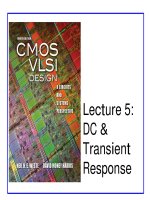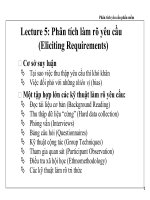lecture 5 hplc
Bạn đang xem bản rút gọn của tài liệu. Xem và tải ngay bản đầy đủ của tài liệu tại đây (233.98 KB, 6 trang )
1
High Performance Liquid
Chromatography (HPLC)
Pham Van Hung, PhD
HPLC
High Performance Liquid Chromatography
(HPLC)
A mixture is injected into a “steel-jacketed” chromatography
column and eluted with solvent at high pressure (4000psi or
approx 130 atm).
Elute with solvent UV detector
Inject sample as gas or liquid.
A solid component can be dissolved in solvent but a solvent
peak will also be seen.
Retention Time- t
R
• The elapsed time between the time of analyte injection
and the time which the maximum peak height for that
compound is detected.
• Different compounds will have different retention
times.
– Each compound will have its own characteristic balance
of attraction to the mobile/stationary phase.
»So they will not move at the same speed.
• Running conditions can also effect t
R
:
– Pressure used, nature of the stationary phase, mobile
phase composition, temperature of the column
2
Retention Time
Time required for the sample to travel from the injection port through
the column to the detector.
Response
Retention Time
5
10
15
20
25
A
B
C
D
Selectivity
Ratio of Net Retention Time of 2 components (Distribution
Coefficient)
X
2
- X
0
X
1
X
0
-
α =
Response
Retention Time
X
X
X
1
3
6
2
1
0
Resolution General Factors Increasing Resolution
• Increase column length
• Decrease column diameter
• Decrease flow-rate
• Pack column uniformly
• Use uniform stationary phase (packing material)
• Decrease sample size
• Select proper stationary phase
• Select proper mobile phase
• Use proper pressure
• Use gradient elution
3
Determining Concentration
• In most cases,
sample peaks
on the
chromatogram
can be used to
estimate the
amount of a
compound
present.
• The more
concentrated,
the stronger
the signal, the
larger the
peak.
/>Types of HPLC
• There are numerous types of HPLC which
vary in their separation chemistry.
– All chromatographic modes are possible:
• Ion-exchange
• Size exclusion
• Also can vary the stationary & mobile
phases:
– Normal phase HPLC
– Reverse phase HPLC
Design & Operation of an HPLC
Instrument
1) Mobile phase degassing:
• Dissolved gases in the mobile phase can come out of
solution and form bubbles as the pressure changes
from the column entrance to the exit.
– May block flow through the system
• Sparging is used to remove any dissolved gas from
the mobile phase.
– An inert and virtually insoluble gas, such as helium, is forced
into the mobile phase solution and drives out any dissolved
gas.
• Degassing may also be achieved by filtering the
mobile phase under a vacuum.
Design & Operation of an HPLC
Instrument
2) Solvent reservoirs:
• Individual reservoirs store the mobile phase
components until
they are mixed
and used.
• May also manually
prepare the mobile
phase mixture and
store in a single
reservoir.
2.
4
3) Mobile phase mixing:
• Solvent proportioning valve can be programmed
to mix specific
amounts of solvent
from the various
reservoirs to
produce the
desired mobile
phase composition.
Design & Operation of an HPLC
Instrument
3.
3) Mobile phase mixing:
• Isocratic elution:
– operate at a single, constant mobile phase composition
• Gradient elution:
– Vary the mobile phase composition with time
– If there is a wide polarity range of components to be eluted.
– Allows for faster runs.
– Ex: mobile phase composition can be programmed to vary
from 75% water: 25% acetonitrile at time zero to
25% water: 75% acetonitrile at the end of the run.
• More polar components will tend to elute first.
• More non-polar components will elute later in the gradient.
Design & Operation of an HPLC
Instrument
Design & Operation of an HPLC
Instrument
4) HPLC pump:
• Fill stroke: mobile phase is pulled from the
solvent side
• Exhaust stroke:
the mobile phase
is pushed from the
injector to the
column head.
– This is where the
high pressure is
generated
4.
5) Injector:
• Introduces the sample
into the mobile phase
stream to be carried
into the
column.
• Syringe = impractical
for use in highly
pressurized systems.
• Rotary injection
valve is used.
Design & Operation of an HPLC
Instrument
5.
5
6) Column:
• Usually constructed of stainless steel
– glass or Tygon may be
used for lower pressur
e
applications (<600 psi).
• Length: 5-100cm
– 10 to 20cm common
•Diameter:
– Typical: 2.1, 3.2, or
4.5mm
– Up to 30mm for preparative applications
Design & Operation of an HPLC
Instrument
6.
• Column packing:
– Usually spherical silica particles of
uniform diameter (2-10µm)
• The smaller particles yield higher
separation efficiencies.
– The silica particles are very porous
• Allows for greater surface area for
interactions between the stationary
phase and the analytes.
– Other packing materials may also be
used:
• Zirconia (ZrO
2
)
/>Design & Operation of an HPLC
Instrument
LC_Book/Adsorbents/ads_part.html
6) Column:
• Guard column: Protects the analytical column
–Particles
–Interferences
–Prolongs the life of the analytical column
• Analytical column
: Performs the separation
Design & Operation of an HPLC
Instrument
7) Detector:
• The component that
emits a response due
to the eluting sample
compound and
subsequently signals
a peak on the
chromatogram.
• A wide variety of
detectors exist.
• Must have high sensitivity-
small sample sizes are used
with most HPLC columns
Design & Operation of an HPLC
Instrument
7.
6
Detection in HPLC
*There are six major HPLC detectors:
• Refractive Index (RI) Detector
• Evaporative Light Scattering Detector (ELSD)
• UV/VIS Absorption Detectors
• The Fluorescence Detector
• Electrochemical Detectors (ECDs)
• Conductivity Detector
* The type of detector
utilized depends on the
characteristics of
the analyte of interest.
/>What is Ultra Performance Liquid
Chromatography?
• 2004: Further advances in column technology
and chromatography instrumentation
– Utilized even smaller packing particle sizes
(1.7µm)
– Higher pressures (15000psi)
– Allowed for significant increases in LC speed,
reproducibility, and sensitivity.
• New research utilizing particle sizes as small
as 1µm and pressures up to 100,000psi!
WHO KNOWS WHAT THE FUTURE MAY BRING!
LC Application in Food System
Carbohydrates
Amino acids, proteins
Vitamins, A, D, E, K
Nucleosides (purines and pyrimidines)
Fatty acids, fats
Aflatoxins
Antioxidants
Contaminants of packaging materials
Carotenoids, chlorophylls
Saccharines
The end!









